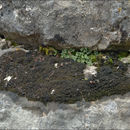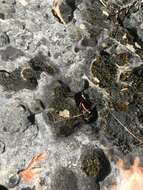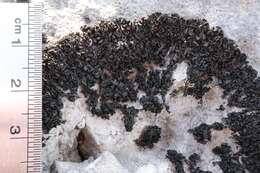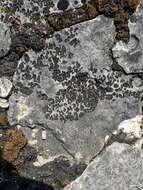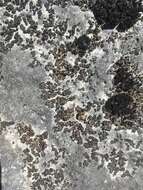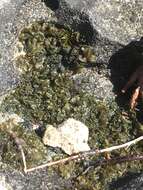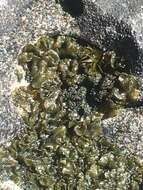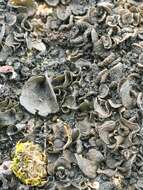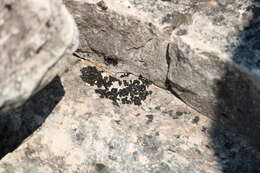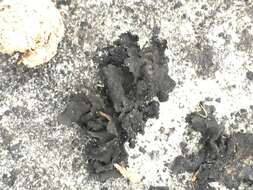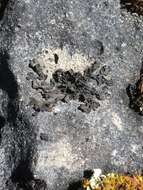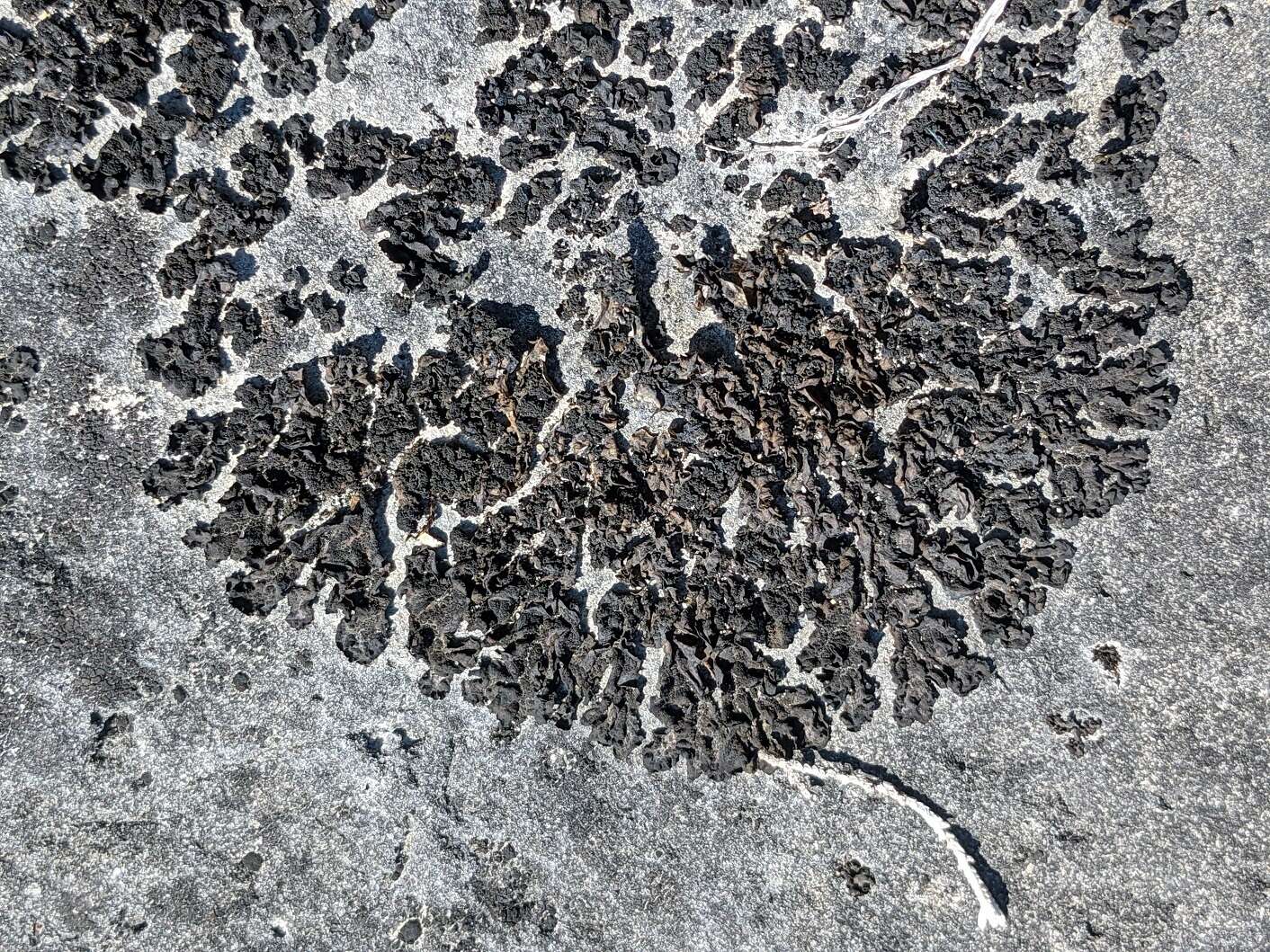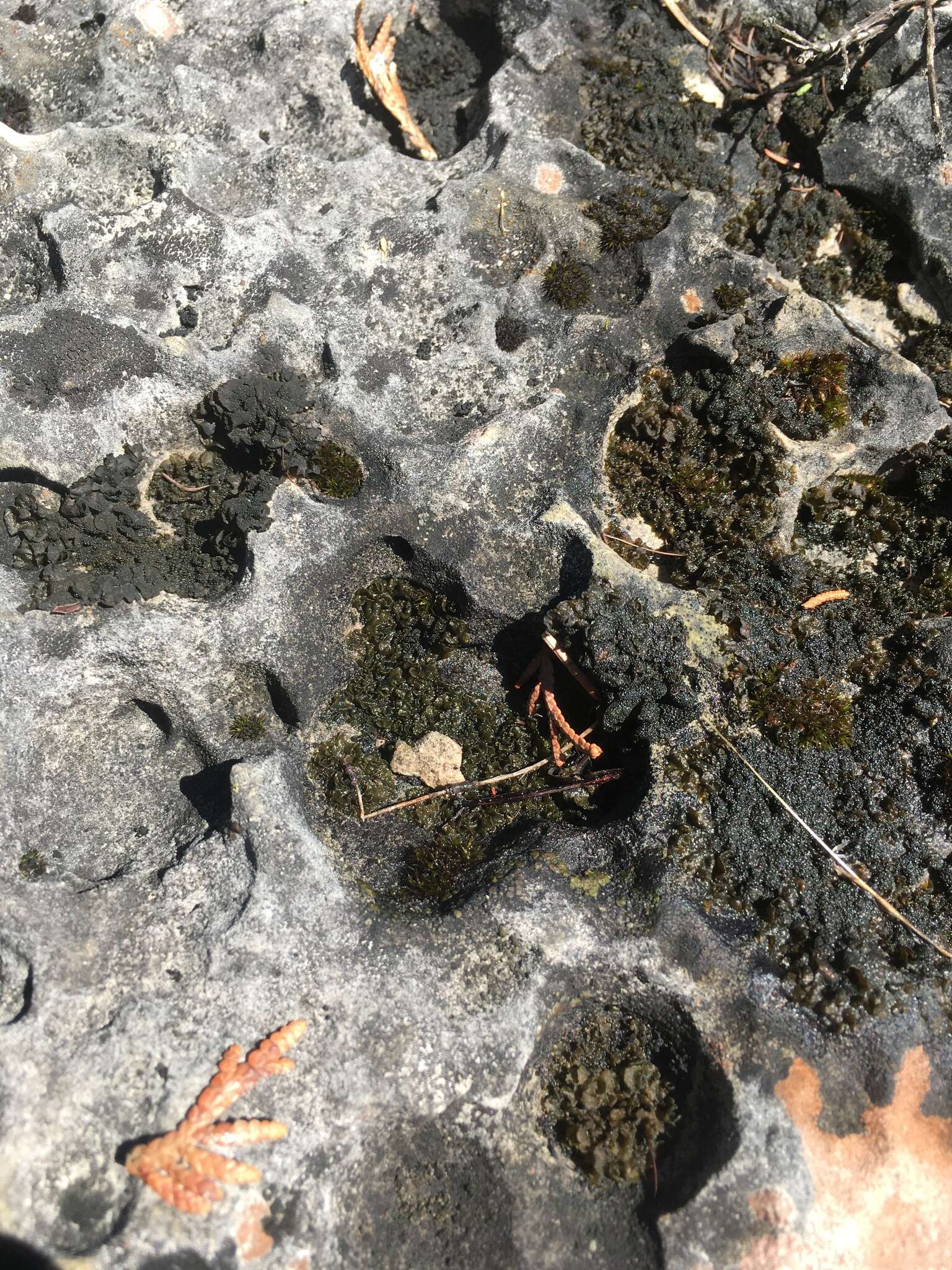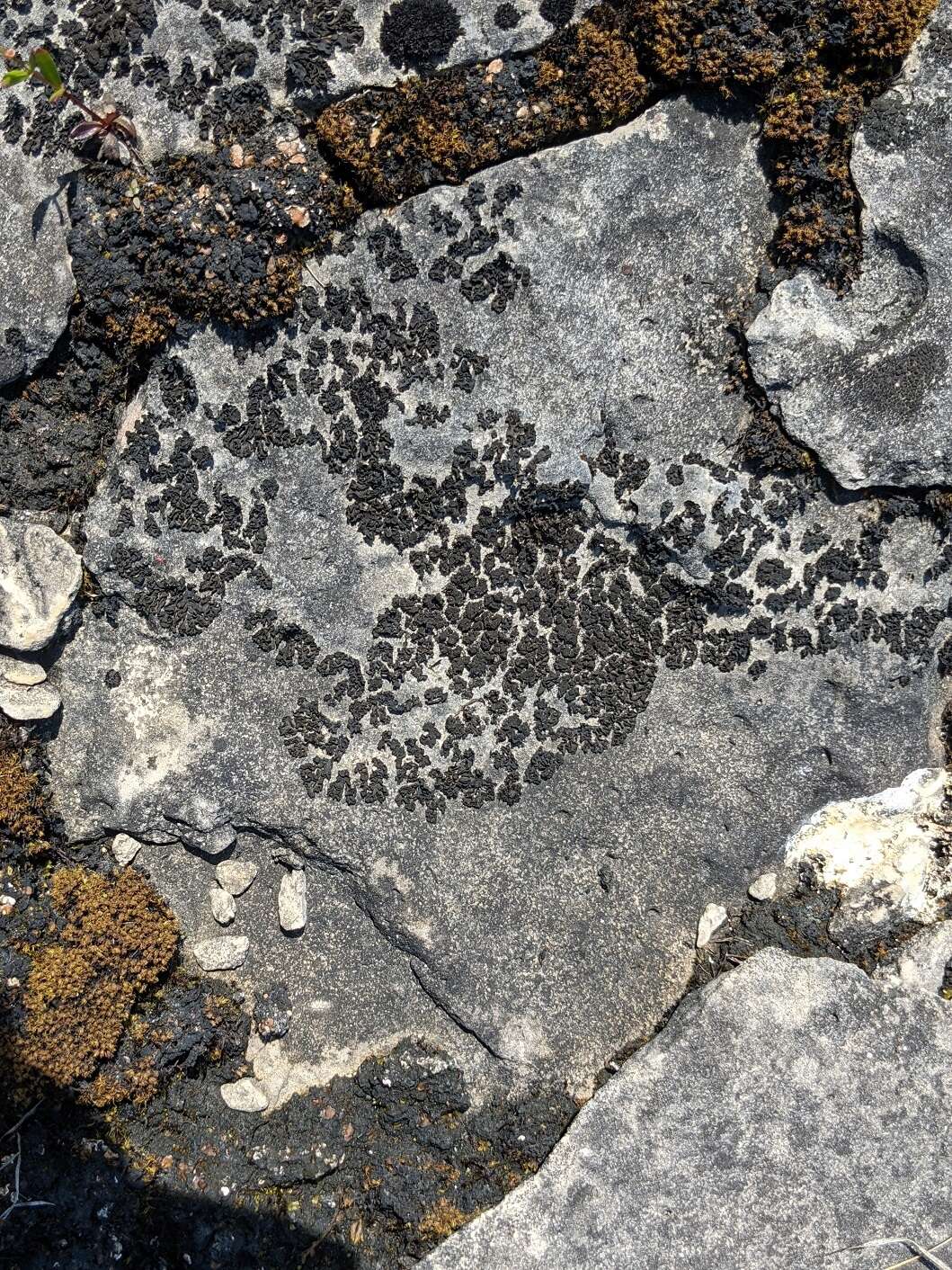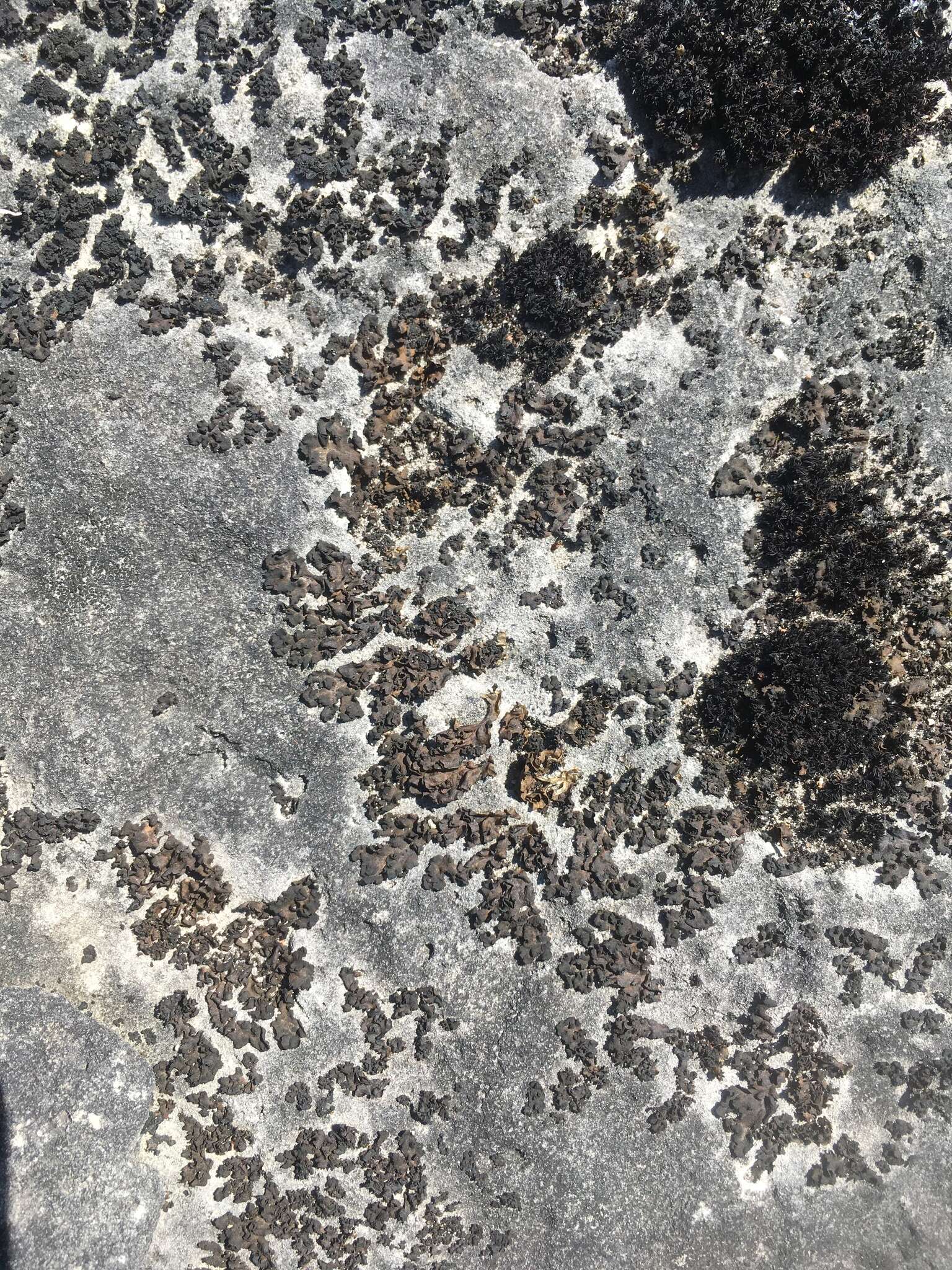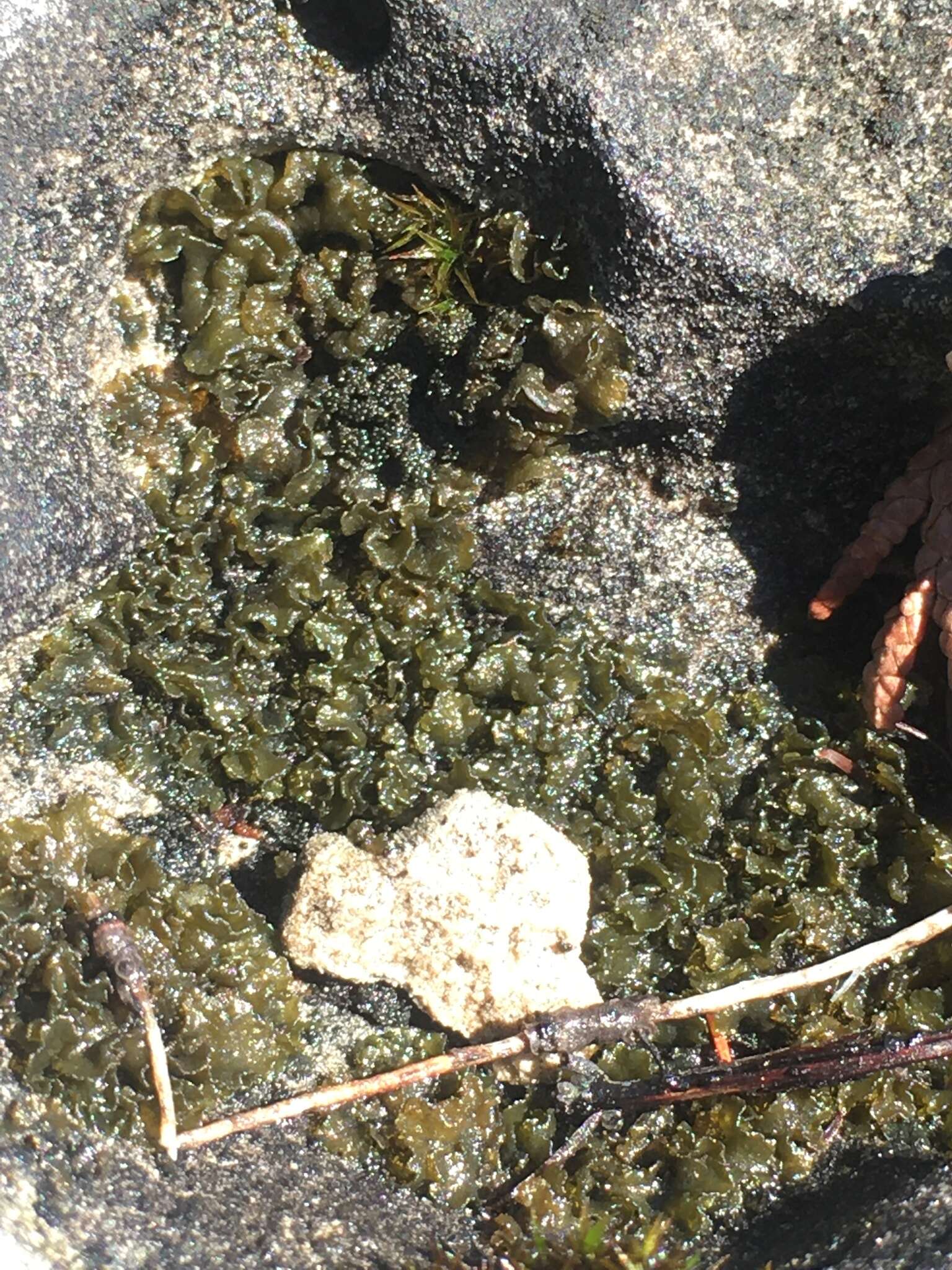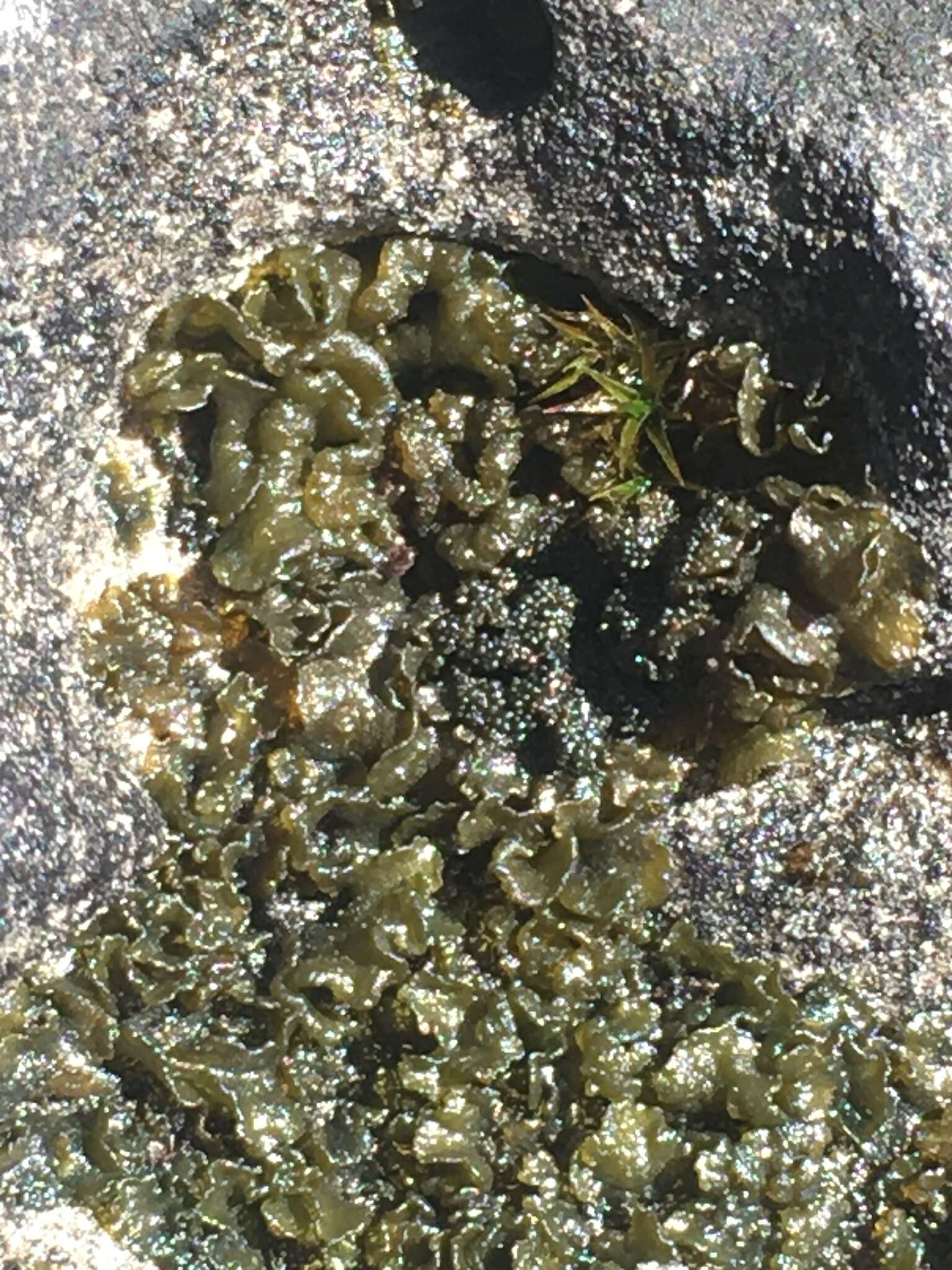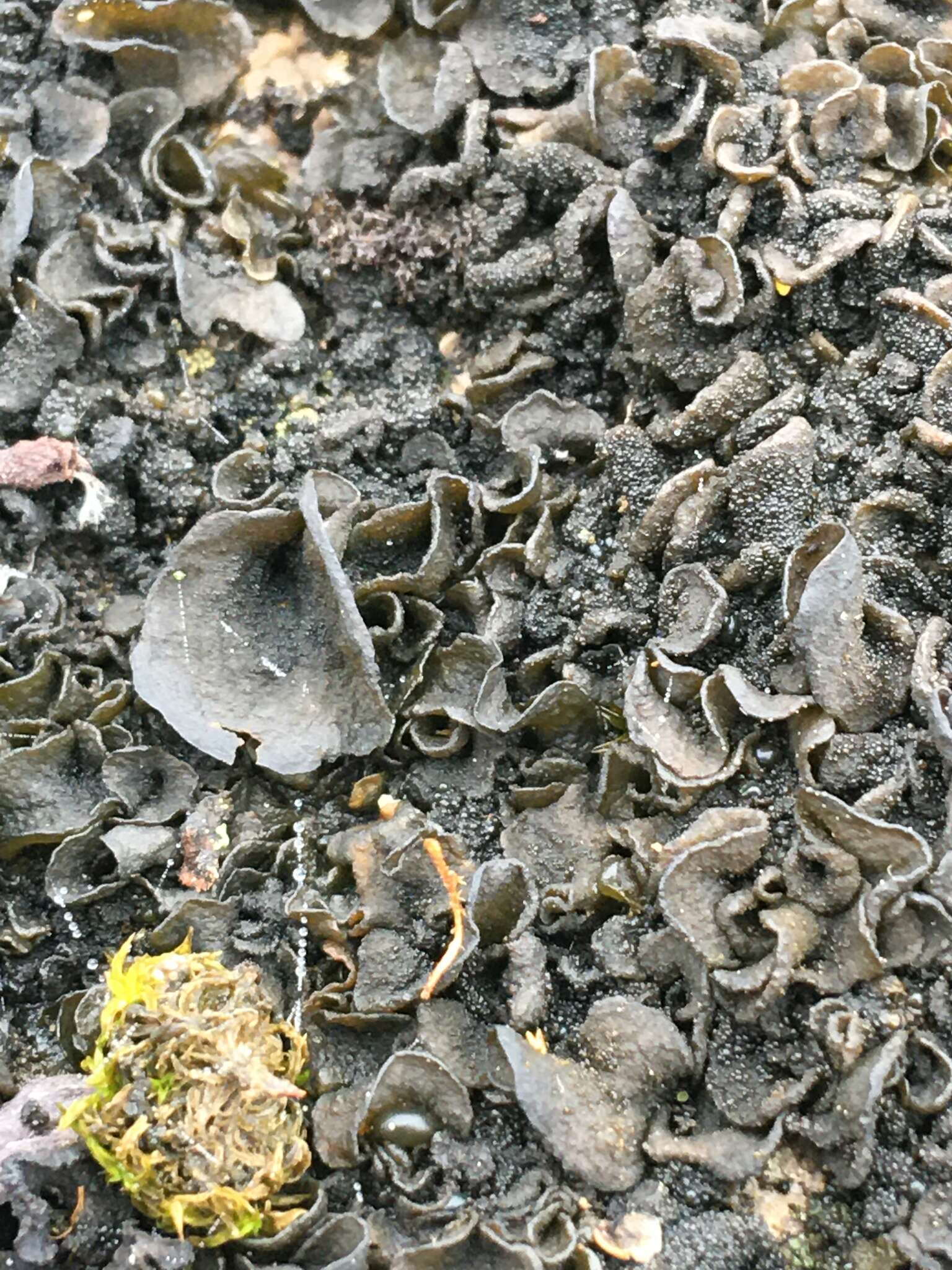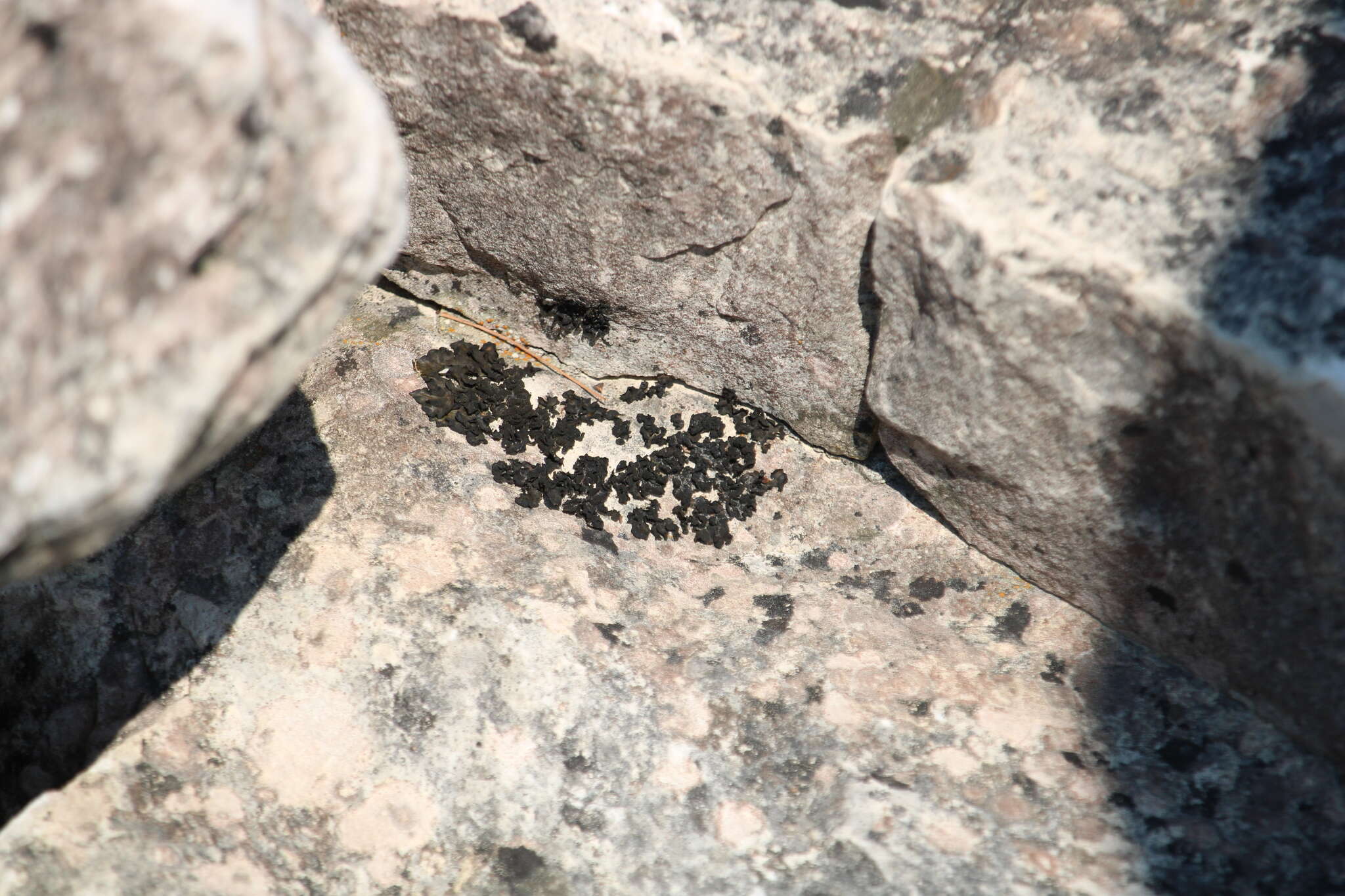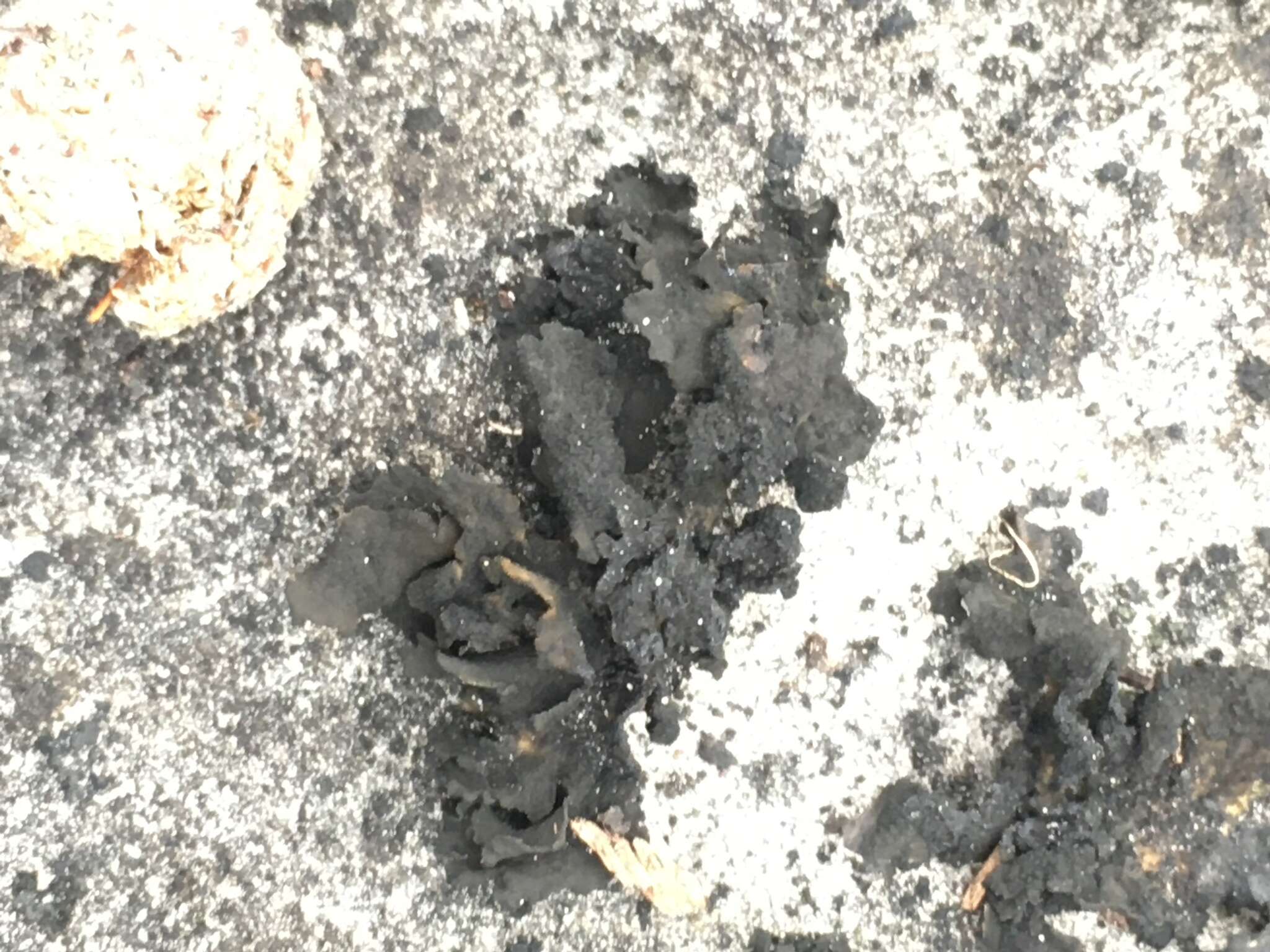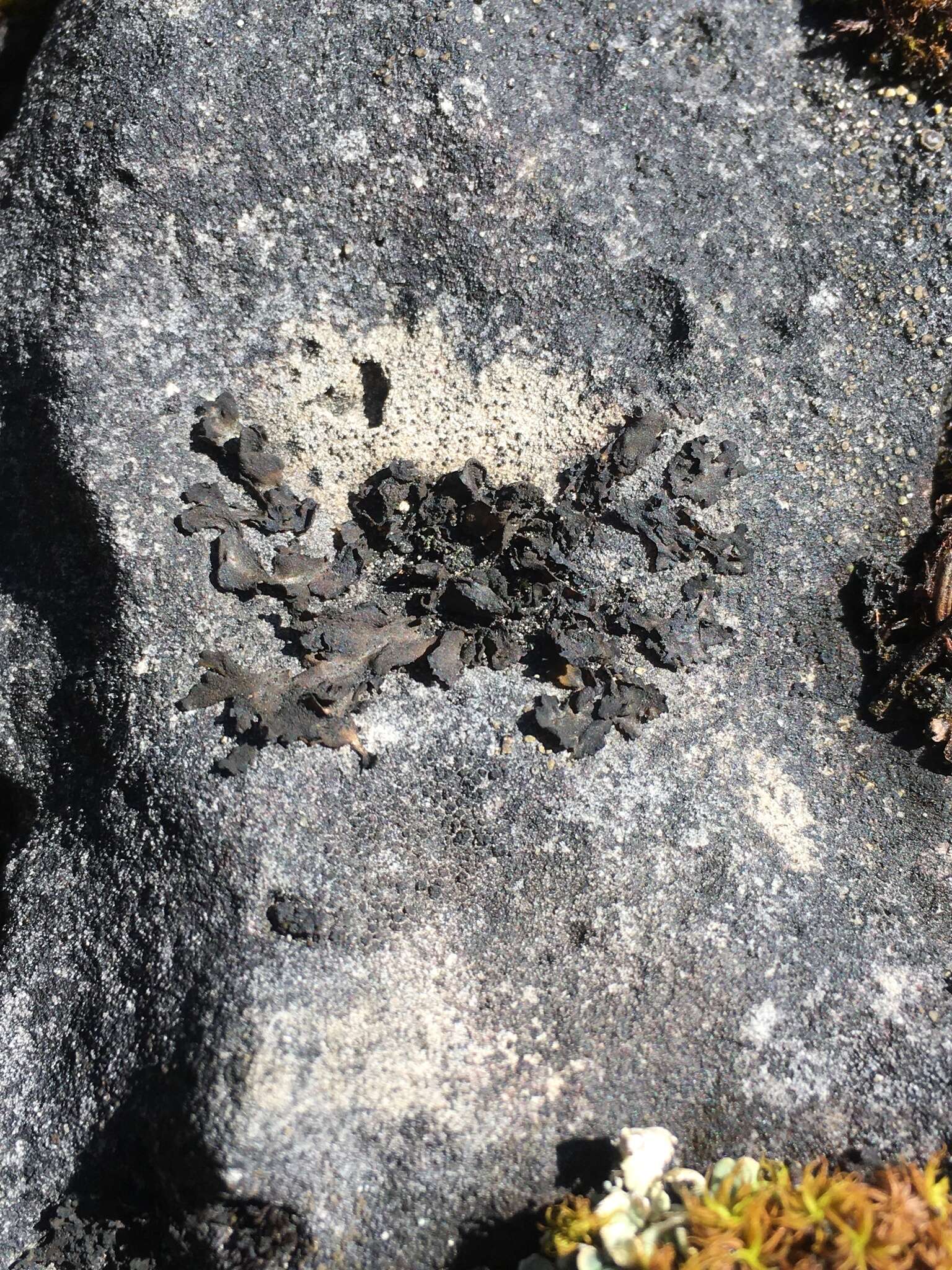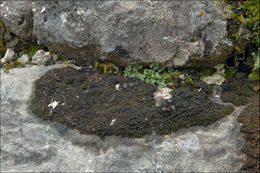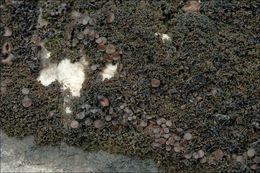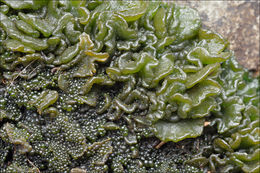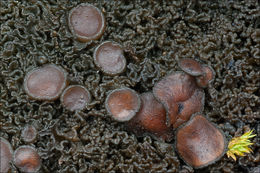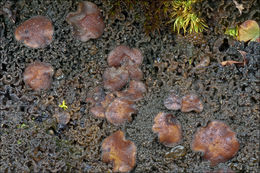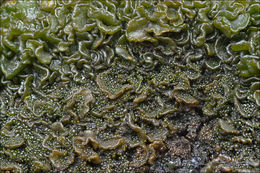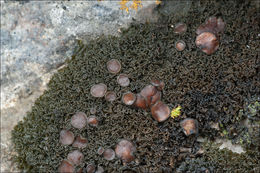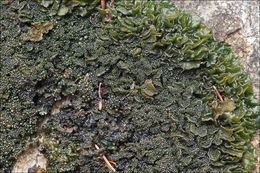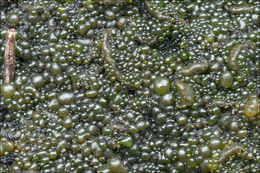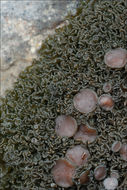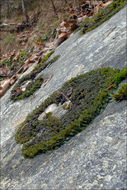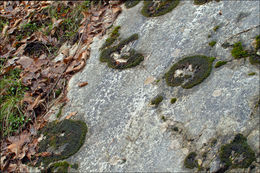-

Slo.: ? - syn.: Collema cristatum (L.) Weber ex F.H. Wigg., Collema multifidum (Scop.) Rabenh - Habitat: steep mountain slope, south-southeast aspect, calcareous ground, open place, full sun, exposed to direct rain, average precipitations ~ 3.000 mm/year, average temperature 5-6 deg C, elevations 790 m (2.600 feet), alpine phytogeographical region. Substratum: calcareous rock in a vertical, stony, manmade road scarp.Comment: Abundant large, reddish-brown, up to 5 mm in diameter apothecia, only sparsely present isidia (see picture 2 lower right) and typical substratum support the determination Lathagrium cristatum. Pictures were taken after a prolonged rainy period. Hence the thallus is waterlogged. Characteristically, the lobes of Lathagrium cristatum do not swale much as with most of other Collema species. The largest thallus had 18 cm in diameter.No chemical tests and microscopy have been done; therefore the determination remains to some extent questionable.Ref.:(1) C.W.Smith, et all, The lichens of Great Britain and Ireland,The British Lichen Society,(2009), p 351.(2) V. Wirth, Die Flechten Baden-Wrttembergs, Teil.1., Ulmer (1995), p 355.(3) F.S. Dobson, Lichens, The Richmonds Publishing Ca.LTD (2005), p 152.(4) I.M. Brodo, S.D. Sharnoff, S.Sharnoff, Lichens of North America, Yale Uni. Press (2001), p 284.(5) http://www.lichens.lastdragon.org/Collema_cristatum.html(6) http://www.stridvall.se/lichens/gallery/Collema/BBBB4229
-
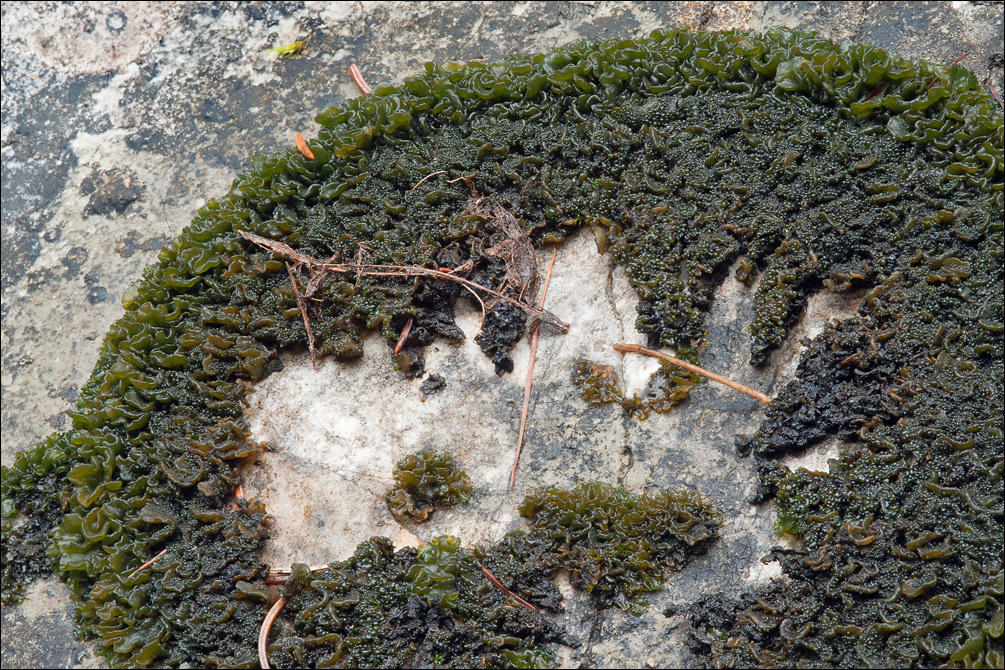
Slo.: ? - syn.: Collema auriculatum Hoffm., Collema auriforme (With.) Coppins & J.R. Laundon, Parmelia auriculata (Hoffm.) Ach., Eucollema auriculatum (Hoffm.) Horw. - Habitat: steep mountain slope, southeast aspect, calcareous ground, open place, full sun, moist place (occasionally rain water seeping over the rock), exposed to direct rain, average precipitations ~ 3.000 mm/year, average temperature 6-7 deg C, elevations 675 m (2.200 feet), alpine phytogeographical region. Substratum: inclined, hard, bare, calcareous bedrock, locally covered by some mosses.Comment: Conspicuous, crowded, bead-like, globose isidia; swollen (particularly at their margins), small, ear-like, upright turned lobes; complete absence of apothecia (several large, mature specimens studied) and substratum speak in favor to Lathagrium auriforme (Index Fungorum, 2014) (= Collema auriforme MycoBank). Pictures were taken after a prolonged period of rainy weather and the lichens were soaked with water. This probably explains relatively bright green color of the lobes at the margin of the thallus. Normally their color is described as 'dark-olive, black-brown, blackish' (Ref.1) or 'dark olive-green, brownish-black, blue-gray' (Ref.2) or 'dark green-brown' (Ref.5) or even black. Circular, dying away in center when old, habitus of the photographed lichen seems to be closer to Collema cristatum with thallus similar to Lathagrium auriforme. However, this species usually has abundant apothecia and isidia are much less frequent or sometimes even missing. Regarding substratum Wirt in both references (Ref.1 and 3) claims for Collema auriforme '...on mosses over calcareous rock...' and only rarely over bare rock, while other sources prefer bare calcareous rock on the first place.No chemical tests and microscopy were done. Hence the determination is not completely sure. Measuring spore dimensions could theoretically distinguish between both these species. However, there were no apothecia found in this find.Ref.:(1) V. Wirth, Die Flechten Baden-Wrttembergs, Teil.1., Ulmer (1995), p 352.(2) C.W.Smith, et all, The lichens of Great Britain and Ireland, The British Lichen Society, (2009), p 348.(3) V. Wirth, R. Duell, Farbatlas Flechten und Moose, Ulmer, (2000), p 106.(4) I.M. Brodo, S.D. Sharnoff, S. Sharnoff, Lichens of North America, Yale Uni. Press (2001), p 284.(5) F.S. Dobson, Lichens, The Richmonds Publishing Ca. LTD (2005), p 150.(6) http://www.mycobank.org/name/Collema%20auriforme&Lang=Eng (7) http://www.speciesfungorum.org/Names/SynSpecies.asp?RecordID=805682(8) http://www.gbif.org/species/5260617 (English vernacular name)
-
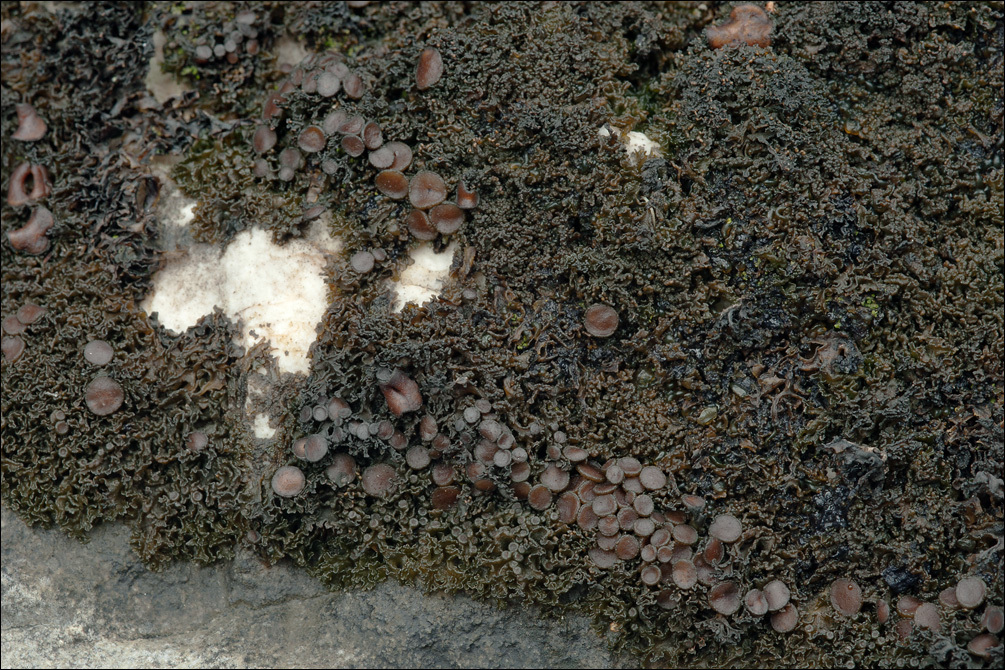
Slo.: ? - syn.: Collema cristatum (L.) Weber ex F.H. Wigg., Collema multifidum (Scop.) Rabenh - Habitat: steep mountain slope, south-southeast aspect, calcareous ground, open place, full sun, exposed to direct rain, average precipitations ~ 3.000 mm/year, average temperature 5-6 deg C, elevations 790 m (2.600 feet), alpine phytogeographical region. Substratum: calcareous rock in a vertical, stony, manmade road scarp. Comment: Abundant large, reddish-brown, up to 5 mm in diameter apothecia, only sparsely present isidia (see picture 2 lower right) and typical substratum support the determination Lathagrium cristatum. Pictures were taken after a prolonged rainy period. Hence the thallus is waterlogged. Characteristically, the lobes of Lathagrium cristatum do not swale much as with most of other Collema species. The largest thallus had 18 cm in diameter. No chemical tests and microscopy have been done; therefore the determination remains to some extent questionable. Ref.: (1) C.W.Smith, et all, The lichens of Great Britain and Ireland,The British Lichen Society,(2009), p 351. (2) V. Wirth, Die Flechten Baden-Wrttembergs, Teil.1., Ulmer (1995), p 355. (3) F.S. Dobson, Lichens, The Richmonds Publishing Ca.LTD (2005), p 152. (4) I.M. Brodo, S.D. Sharnoff, S.Sharnoff, Lichens of North America, Yale Uni. Press (2001), p 284. (5) http://www.lichens.lastdragon.org/Collema_cristatum.html (6) http://www.stridvall.se/lichens/gallery/Collema/BBBB4229
-
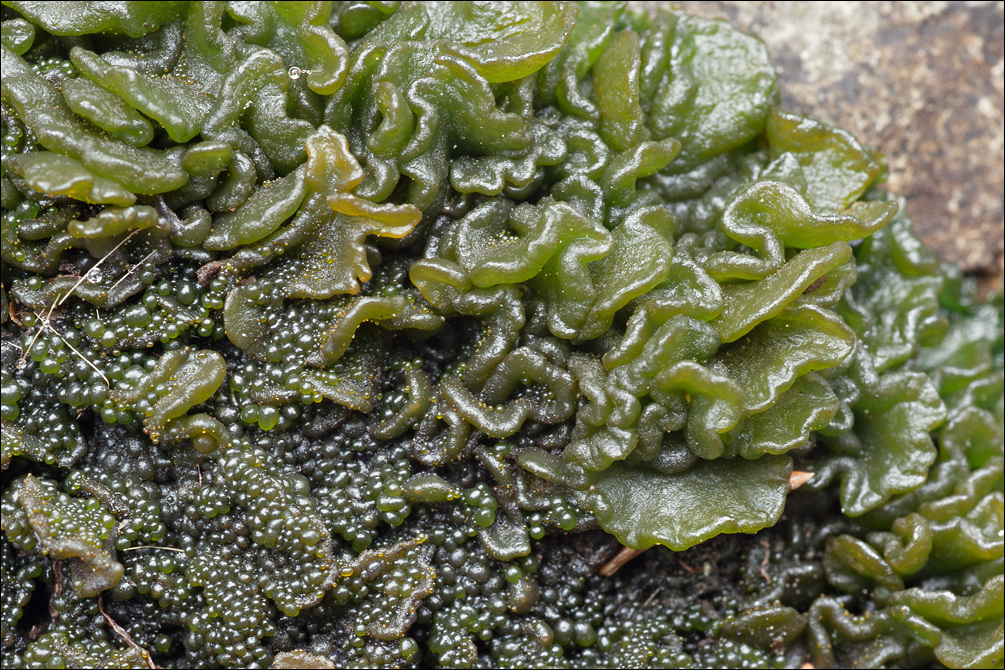
Slo.: ? - syn.: Collema auriculatum Hoffm., Collema auriforme (With.) Coppins & J.R. Laundon, Parmelia auriculata (Hoffm.) Ach., Eucollema auriculatum (Hoffm.) Horw. - Habitat: steep mountain slope, southeast aspect, calcareous ground, open place, full sun, moist place (occasionally rain water seeping over the rock), exposed to direct rain, average precipitations ~ 3.000 mm/year, average temperature 6-7 deg C, elevations 675 m (2.200 feet), alpine phytogeographical region. Substratum: inclined, hard, bare, calcareous bedrock, locally covered by some mosses. Comment: Conspicuous, crowded, bead-like, globose isidia; swollen (particularly at their margins), small, ear-like, upright turned lobes; complete absence of apothecia (several large, mature specimens studied) and substratum speak in favor to Lathagrium auriforme (Index Fungorum, 2014) (= Collema auriforme MycoBank). Pictures were taken after a prolonged period of rainy weather and the lichens were soaked with water. This probably explains relatively bright green color of the lobes at the margin of the thallus. Normally their color is described as 'dark-olive, black-brown, blackish' (Ref.1) or 'dark olive-green, brownish-black, blue-gray' (Ref.2) or 'dark green-brown' (Ref.5) or even black. Circular, dying away in center when old, habitus of the photographed lichen seems to be closer to Collema cristatum with thallus similar to Lathagrium auriforme. However, this species usually has abundant apothecia and isidia are much less frequent or sometimes even missing. Regarding substratum Wirt in both references (Ref.1 and 3) claims for Collema auriforme '...on mosses over calcareous rock...' and only rarely over bare rock, while other sources prefer bare calcareous rock on the first place. No chemical tests and microscopy were done. Hence the determination is not completely sure. Measuring spore dimensions could theoretically distinguish between both these species. However, there were no apothecia found in this find. Ref.: (1) V. Wirth, Die Flechten Baden-Wrttembergs, Teil.1., Ulmer (1995), p 352. (2) C.W.Smith, et all, The lichens of Great Britain and Ireland, The British Lichen Society, (2009), p 348. (3) V. Wirth, R. Duell, Farbatlas Flechten und Moose, Ulmer, (2000), p 106. (4) I.M. Brodo, S.D. Sharnoff, S. Sharnoff, Lichens of North America, Yale Uni. Press (2001), p 284. (5) F.S. Dobson, Lichens, The Richmonds Publishing Ca. LTD (2005), p 150. (6) http://www.mycobank.org/name/Collema%20auriforme&Lang=Eng (7) http://www.speciesfungorum.org/Names/SynSpecies.asp?RecordID=805682 (8) http://www.gbif.org/species/5260617 (English vernacular name)
-

Slo.: ? - syn.: Collema cristatum (L.) Weber ex F.H. Wigg., Collema multifidum (Scop.) Rabenh - Habitat: steep mountain slope, south-southeast aspect, calcareous ground, open place, full sun, exposed to direct rain, average precipitations ~ 3.000 mm/year, average temperature 5-6 deg C, elevations 790 m (2.600 feet), alpine phytogeographical region. Substratum: calcareous rock in a vertical, stony, manmade road scarp. Comment: Abundant large, reddish-brown, up to 5 mm in diameter apothecia, only sparsely present isidia (see picture 2 lower right) and typical substratum support the determination Lathagrium cristatum. Pictures were taken after a prolonged rainy period. Hence the thallus is waterlogged. Characteristically, the lobes of Lathagrium cristatum do not swale much as with most of other Collema species. The largest thallus had 18 cm in diameter. No chemical tests and microscopy have been done; therefore the determination remains to some extent questionable. Ref.: (1) C.W.Smith, et all, The lichens of Great Britain and Ireland,The British Lichen Society,(2009), p 351. (2) V. Wirth, Die Flechten Baden-Wrttembergs, Teil.1., Ulmer (1995), p 355. (3) F.S. Dobson, Lichens, The Richmonds Publishing Ca.LTD (2005), p 152. (4) I.M. Brodo, S.D. Sharnoff, S.Sharnoff, Lichens of North America, Yale Uni. Press (2001), p 284. (5) http://www.lichens.lastdragon.org/Collema_cristatum.html (6) http://www.stridvall.se/lichens/gallery/Collema/BBBB4229
-
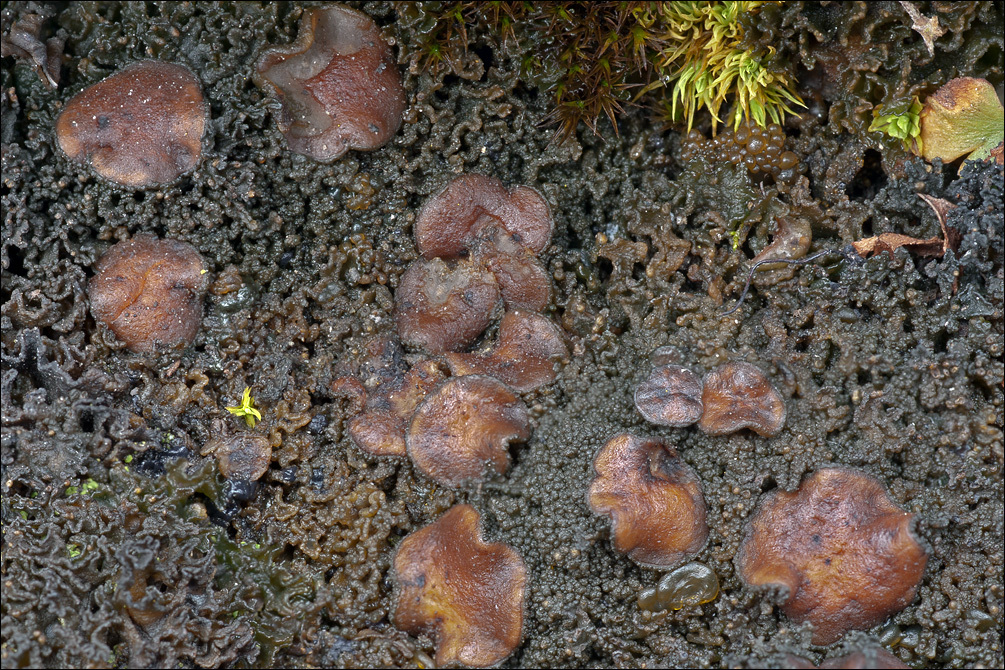
Slo.: ? - syn.: Collema cristatum (L.) Weber ex F.H. Wigg., Collema multifidum (Scop.) Rabenh - Habitat: steep mountain slope, south-southeast aspect, calcareous ground, open place, full sun, exposed to direct rain, average precipitations ~ 3.000 mm/year, average temperature 5-6 deg C, elevations 790 m (2.600 feet), alpine phytogeographical region. Substratum: calcareous rock in a vertical, stony, manmade road scarp. Comment: Abundant large, reddish-brown, up to 5 mm in diameter apothecia, only sparsely present isidia (see picture 2 lower right) and typical substratum support the determination Lathagrium cristatum. Pictures were taken after a prolonged rainy period. Hence the thallus is waterlogged. Characteristically, the lobes of Lathagrium cristatum do not swale much as with most of other Collema species. The largest thallus had 18 cm in diameter. No chemical tests and microscopy have been done; therefore the determination remains to some extent questionable. Ref.: (1) C.W.Smith, et all, The lichens of Great Britain and Ireland,The British Lichen Society,(2009), p 351. (2) V. Wirth, Die Flechten Baden-Wrttembergs, Teil.1., Ulmer (1995), p 355. (3) F.S. Dobson, Lichens, The Richmonds Publishing Ca.LTD (2005), p 152. (4) I.M. Brodo, S.D. Sharnoff, S.Sharnoff, Lichens of North America, Yale Uni. Press (2001), p 284. (5) http://www.lichens.lastdragon.org/Collema_cristatum.html (6) http://www.stridvall.se/lichens/gallery/Collema/BBBB4229
-
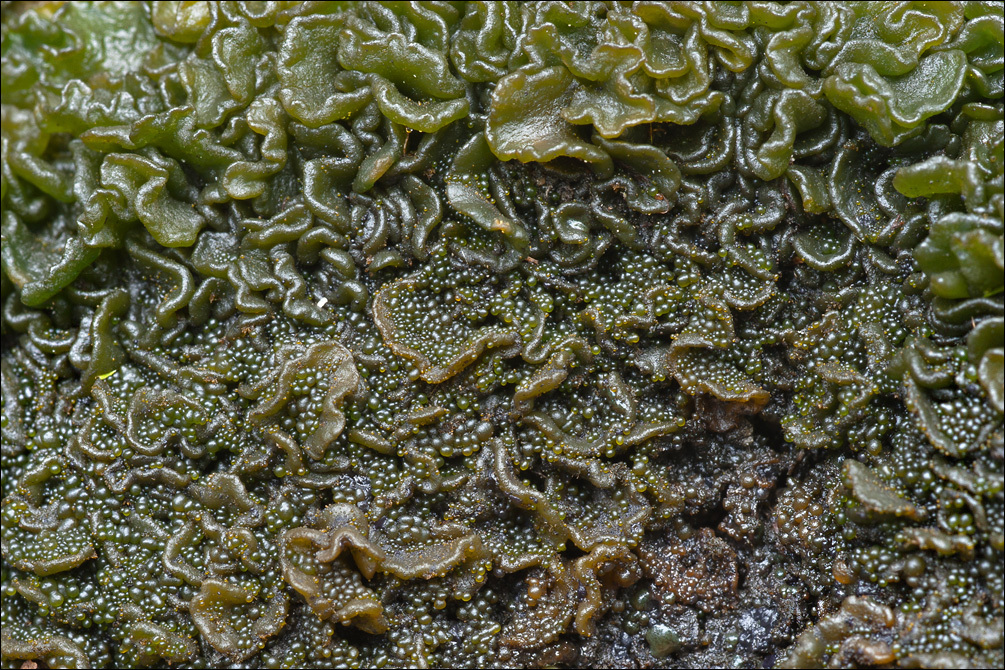
Slo.: ? - syn.: Collema auriculatum Hoffm., Collema auriforme (With.) Coppins & J.R. Laundon, Parmelia auriculata (Hoffm.) Ach., Eucollema auriculatum (Hoffm.) Horw. - Habitat: steep mountain slope, southeast aspect, calcareous ground, open place, full sun, moist place (occasionally rain water seeping over the rock), exposed to direct rain, average precipitations ~ 3.000 mm/year, average temperature 6-7 deg C, elevations 675 m (2.200 feet), alpine phytogeographical region. Substratum: inclined, hard, bare, calcareous bedrock, locally covered by some mosses. Comment: Conspicuous, crowded, bead-like, globose isidia; swollen (particularly at their margins), small, ear-like, upright turned lobes; complete absence of apothecia (several large, mature specimens studied) and substratum speak in favor to Lathagrium auriforme (Index Fungorum, 2014) (= Collema auriforme MycoBank). Pictures were taken after a prolonged period of rainy weather and the lichens were soaked with water. This probably explains relatively bright green color of the lobes at the margin of the thallus. Normally their color is described as 'dark-olive, black-brown, blackish' (Ref.1) or 'dark olive-green, brownish-black, blue-gray' (Ref.2) or 'dark green-brown' (Ref.5) or even black. Circular, dying away in center when old, habitus of the photographed lichen seems to be closer to Collema cristatum with thallus similar to Lathagrium auriforme. However, this species usually has abundant apothecia and isidia are much less frequent or sometimes even missing. Regarding substratum Wirt in both references (Ref.1 and 3) claims for Collema auriforme '...on mosses over calcareous rock...' and only rarely over bare rock, while other sources prefer bare calcareous rock on the first place. No chemical tests and microscopy were done. Hence the determination is not completely sure. Measuring spore dimensions could theoretically distinguish between both these species. However, there were no apothecia found in this find. Ref.: (1) V. Wirth, Die Flechten Baden-Wrttembergs, Teil.1., Ulmer (1995), p 352. (2) C.W.Smith, et all, The lichens of Great Britain and Ireland, The British Lichen Society, (2009), p 348. (3) V. Wirth, R. Duell, Farbatlas Flechten und Moose, Ulmer, (2000), p 106. (4) I.M. Brodo, S.D. Sharnoff, S. Sharnoff, Lichens of North America, Yale Uni. Press (2001), p 284. (5) F.S. Dobson, Lichens, The Richmonds Publishing Ca. LTD (2005), p 150. (6) http://www.mycobank.org/name/Collema%20auriforme&Lang=Eng (7) http://www.speciesfungorum.org/Names/SynSpecies.asp?RecordID=805682 (8) http://www.gbif.org/species/5260617 (English vernacular name)
-

Slo.: ? - syn.: Collema cristatum (L.) Weber ex F.H. Wigg., Collema multifidum (Scop.) Rabenh - Habitat: steep mountain slope, south-southeast aspect, calcareous ground, open place, full sun, exposed to direct rain, average precipitations ~ 3.000 mm/year, average temperature 5-6 deg C, elevations 790 m (2.600 feet), alpine phytogeographical region. Substratum: calcareous rock in a vertical, stony, manmade road scarp. Comment: Abundant large, reddish-brown, up to 5 mm in diameter apothecia, only sparsely present isidia (see picture 2 lower right) and typical substratum support the determination Lathagrium cristatum. Pictures were taken after a prolonged rainy period. Hence the thallus is waterlogged. Characteristically, the lobes of Lathagrium cristatum do not swale much as with most of other Collema species. The largest thallus had 18 cm in diameter. No chemical tests and microscopy have been done; therefore the determination remains to some extent questionable. Ref.: (1) C.W.Smith, et all, The lichens of Great Britain and Ireland,The British Lichen Society,(2009), p 351. (2) V. Wirth, Die Flechten Baden-Wrttembergs, Teil.1., Ulmer (1995), p 355. (3) F.S. Dobson, Lichens, The Richmonds Publishing Ca.LTD (2005), p 152. (4) I.M. Brodo, S.D. Sharnoff, S.Sharnoff, Lichens of North America, Yale Uni. Press (2001), p 284. (5) http://www.lichens.lastdragon.org/Collema_cristatum.html (6) http://www.stridvall.se/lichens/gallery/Collema/BBBB4229
-
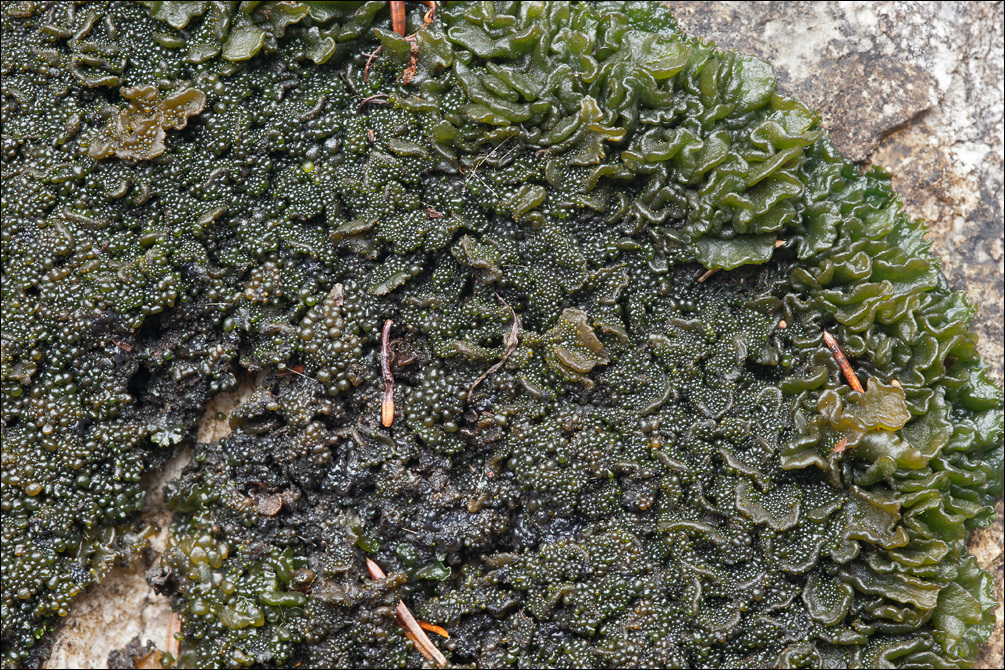
Slo.: ? - syn.: Collema auriculatum Hoffm., Collema auriforme (With.) Coppins & J.R. Laundon, Parmelia auriculata (Hoffm.) Ach., Eucollema auriculatum (Hoffm.) Horw. - Habitat: steep mountain slope, southeast aspect, calcareous ground, open place, full sun, moist place (occasionally rain water seeping over the rock), exposed to direct rain, average precipitations ~ 3.000 mm/year, average temperature 6-7 deg C, elevations 675 m (2.200 feet), alpine phytogeographical region. Substratum: inclined, hard, bare, calcareous bedrock, locally covered by some mosses. Comment: Conspicuous, crowded, bead-like, globose isidia; swollen (particularly at their margins), small, ear-like, upright turned lobes; complete absence of apothecia (several large, mature specimens studied) and substratum speak in favor to Lathagrium auriforme (Index Fungorum, 2014) (= Collema auriforme MycoBank). Pictures were taken after a prolonged period of rainy weather and the lichens were soaked with water. This probably explains relatively bright green color of the lobes at the margin of the thallus. Normally their color is described as 'dark-olive, black-brown, blackish' (Ref.1) or 'dark olive-green, brownish-black, blue-gray' (Ref.2) or 'dark green-brown' (Ref.5) or even black. Circular, dying away in center when old, habitus of the photographed lichen seems to be closer to Collema cristatum with thallus similar to Lathagrium auriforme. However, this species usually has abundant apothecia and isidia are much less frequent or sometimes even missing. Regarding substratum Wirt in both references (Ref.1 and 3) claims for Collema auriforme '...on mosses over calcareous rock...' and only rarely over bare rock, while other sources prefer bare calcareous rock on the first place. No chemical tests and microscopy were done. Hence the determination is not completely sure. Measuring spore dimensions could theoretically distinguish between both these species. However, there were no apothecia found in this find. Ref.: (1) V. Wirth, Die Flechten Baden-Wrttembergs, Teil.1., Ulmer (1995), p 352. (2) C.W.Smith, et all, The lichens of Great Britain and Ireland, The British Lichen Society, (2009), p 348. (3) V. Wirth, R. Duell, Farbatlas Flechten und Moose, Ulmer, (2000), p 106. (4) I.M. Brodo, S.D. Sharnoff, S. Sharnoff, Lichens of North America, Yale Uni. Press (2001), p 284. (5) F.S. Dobson, Lichens, The Richmonds Publishing Ca. LTD (2005), p 150. (6) http://www.mycobank.org/name/Collema%20auriforme&Lang=Eng (7) http://www.speciesfungorum.org/Names/SynSpecies.asp?RecordID=805682 (8) http://www.gbif.org/species/5260617 (English vernacular name)
-
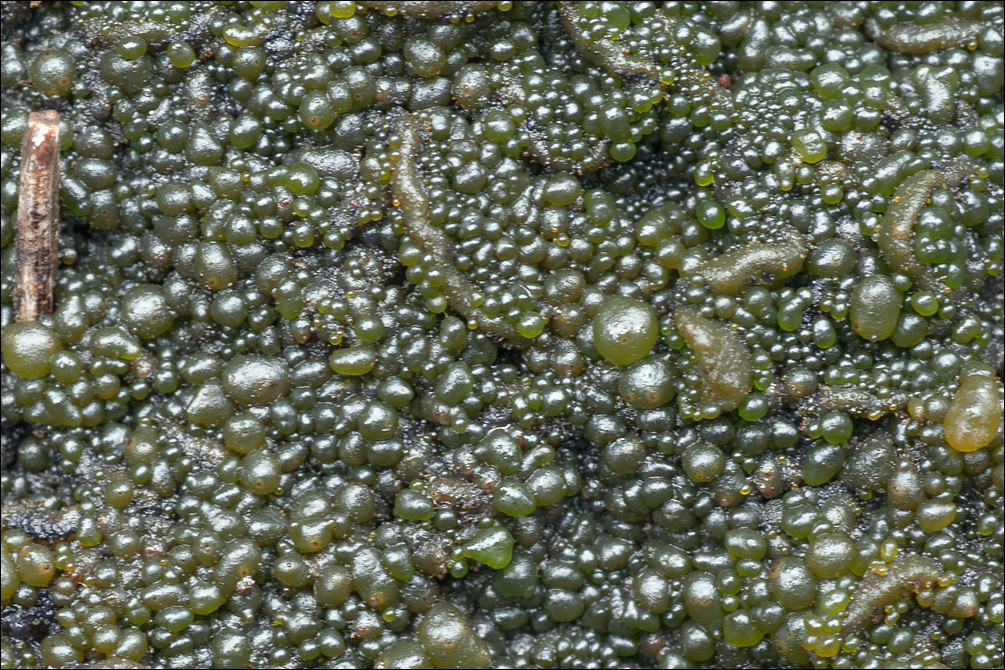
Slo.: ? - syn.: Collema auriculatum Hoffm., Collema auriforme (With.) Coppins & J.R. Laundon, Parmelia auriculata (Hoffm.) Ach., Eucollema auriculatum (Hoffm.) Horw. - Habitat: steep mountain slope, southeast aspect, calcareous ground, open place, full sun, moist place (occasionally rain water seeping over the rock), exposed to direct rain, average precipitations ~ 3.000 mm/year, average temperature 6-7 deg C, elevations 675 m (2.200 feet), alpine phytogeographical region. Substratum: inclined, hard, bare, calcareous bedrock, locally covered by some mosses. Comment: Conspicuous, crowded, bead-like, globose isidia; swollen (particularly at their margins), small, ear-like, upright turned lobes; complete absence of apothecia (several large, mature specimens studied) and substratum speak in favor to Lathagrium auriforme (Index Fungorum, 2014) (= Collema auriforme MycoBank). Pictures were taken after a prolonged period of rainy weather and the lichens were soaked with water. This probably explains relatively bright green color of the lobes at the margin of the thallus. Normally their color is described as 'dark-olive, black-brown, blackish' (Ref.1) or 'dark olive-green, brownish-black, blue-gray' (Ref.2) or 'dark green-brown' (Ref.5) or even black. Circular, dying away in center when old, habitus of the photographed lichen seems to be closer to Collema cristatum with thallus similar to Lathagrium auriforme. However, this species usually has abundant apothecia and isidia are much less frequent or sometimes even missing. Regarding substratum Wirt in both references (Ref.1 and 3) claims for Collema auriforme '...on mosses over calcareous rock...' and only rarely over bare rock, while other sources prefer bare calcareous rock on the first place. No chemical tests and microscopy were done. Hence the determination is not completely sure. Measuring spore dimensions could theoretically distinguish between both these species. However, there were no apothecia found in this find. Ref.: (1) V. Wirth, Die Flechten Baden-Wrttembergs, Teil.1., Ulmer (1995), p 352. (2) C.W.Smith, et all, The lichens of Great Britain and Ireland, The British Lichen Society, (2009), p 348. (3) V. Wirth, R. Duell, Farbatlas Flechten und Moose, Ulmer, (2000), p 106. (4) I.M. Brodo, S.D. Sharnoff, S. Sharnoff, Lichens of North America, Yale Uni. Press (2001), p 284. (5) F.S. Dobson, Lichens, The Richmonds Publishing Ca. LTD (2005), p 150. (6) http://www.mycobank.org/name/Collema%20auriforme&Lang=Eng (7) http://www.speciesfungorum.org/Names/SynSpecies.asp?RecordID=805682 (8) http://www.gbif.org/species/5260617 (English vernacular name)
-

Slo.: ? - syn.: Collema cristatum (L.) Weber ex F.H. Wigg., Collema multifidum (Scop.) Rabenh - Habitat: steep mountain slope, south-southeast aspect, calcareous ground, open place, full sun, exposed to direct rain, average precipitations ~ 3.000 mm/year, average temperature 5-6 deg C, elevations 790 m (2.600 feet), alpine phytogeographical region. Substratum: calcareous rock in a vertical, stony, manmade road scarp. Comment: Abundant large, reddish-brown, up to 5 mm in diameter apothecia, only sparsely present isidia (see picture 2 lower right) and typical substratum support the determination Lathagrium cristatum. Pictures were taken after a prolonged rainy period. Hence the thallus is waterlogged. Characteristically, the lobes of Lathagrium cristatum do not swale much as with most of other Collema species. The largest thallus had 18 cm in diameter. No chemical tests and microscopy have been done; therefore the determination remains to some extent questionable. Ref.: (1) C.W.Smith, et all, The lichens of Great Britain and Ireland,The British Lichen Society,(2009), p 351. (2) V. Wirth, Die Flechten Baden-Wrttembergs, Teil.1., Ulmer (1995), p 355. (3) F.S. Dobson, Lichens, The Richmonds Publishing Ca.LTD (2005), p 152. (4) I.M. Brodo, S.D. Sharnoff, S.Sharnoff, Lichens of North America, Yale Uni. Press (2001), p 284. (5) http://www.lichens.lastdragon.org/Collema_cristatum.html (6) http://www.stridvall.se/lichens/gallery/Collema/BBBB4229
-

Slo.: ? - syn.: Collema auriculatum Hoffm., Collema auriforme (With.) Coppins & J.R. Laundon, Parmelia auriculata (Hoffm.) Ach., Eucollema auriculatum (Hoffm.) Horw. - Habitat: steep mountain slope, southeast aspect, calcareous ground, open place, full sun, moist place (occasionally rain water seeping over the rock), exposed to direct rain, average precipitations ~ 3.000 mm/year, average temperature 6-7 deg C, elevations 675 m (2.200 feet), alpine phytogeographical region. Substratum: inclined, hard, bare, calcareous bedrock, locally covered by some mosses. Comment: Conspicuous, crowded, bead-like, globose isidia; swollen (particularly at their margins), small, ear-like, upright turned lobes; complete absence of apothecia (several large, mature specimens studied) and substratum speak in favor to Lathagrium auriforme (Index Fungorum, 2014) (= Collema auriforme MycoBank). Pictures were taken after a prolonged period of rainy weather and the lichens were soaked with water. This probably explains relatively bright green color of the lobes at the margin of the thallus. Normally their color is described as 'dark-olive, black-brown, blackish' (Ref.1) or 'dark olive-green, brownish-black, blue-gray' (Ref.2) or 'dark green-brown' (Ref.5) or even black. Circular, dying away in center when old, habitus of the photographed lichen seems to be closer to Collema cristatum with thallus similar to Lathagrium auriforme. However, this species usually has abundant apothecia and isidia are much less frequent or sometimes even missing. Regarding substratum Wirt in both references (Ref.1 and 3) claims for Collema auriforme '...on mosses over calcareous rock...' and only rarely over bare rock, while other sources prefer bare calcareous rock on the first place. No chemical tests and microscopy were done. Hence the determination is not completely sure. Measuring spore dimensions could theoretically distinguish between both these species. However, there were no apothecia found in this find. Ref.: (1) V. Wirth, Die Flechten Baden-Wrttembergs, Teil.1., Ulmer (1995), p 352. (2) C.W.Smith, et all, The lichens of Great Britain and Ireland, The British Lichen Society, (2009), p 348. (3) V. Wirth, R. Duell, Farbatlas Flechten und Moose, Ulmer, (2000), p 106. (4) I.M. Brodo, S.D. Sharnoff, S. Sharnoff, Lichens of North America, Yale Uni. Press (2001), p 284. (5) F.S. Dobson, Lichens, The Richmonds Publishing Ca. LTD (2005), p 150. (6) http://www.mycobank.org/name/Collema%20auriforme&Lang=Eng (7) http://www.speciesfungorum.org/Names/SynSpecies.asp?RecordID=805682 (8) http://www.gbif.org/species/5260617 (English vernacular name)
-
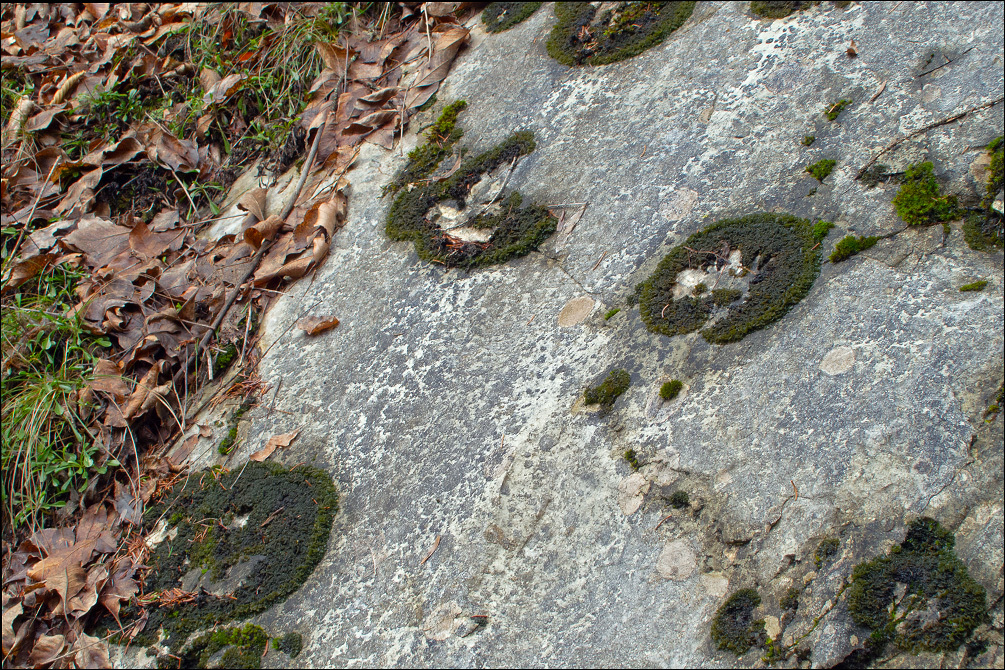
Slo.: ? - syn.: Collema auriculatum Hoffm., Collema auriforme (With.) Coppins & J.R. Laundon, Parmelia auriculata (Hoffm.) Ach., Eucollema auriculatum (Hoffm.) Horw. - Habitat: steep mountain slope, southeast aspect, calcareous ground, open place, full sun, moist place (occasionally rain water seeping over the rock), exposed to direct rain, average precipitations ~ 3.000 mm/year, average temperature 6-7 deg C, elevations 675 m (2.200 feet), alpine phytogeographical region. Substratum: inclined, hard, bare, calcareous bedrock, locally covered by some mosses. Comment: Conspicuous, crowded, bead-like, globose isidia; swollen (particularly at their margins), small, ear-like, upright turned lobes; complete absence of apothecia (several large, mature specimens studied) and substratum speak in favor to Lathagrium auriforme (Index Fungorum, 2014) (= Collema auriforme MycoBank). Pictures were taken after a prolonged period of rainy weather and the lichens were soaked with water. This probably explains relatively bright green color of the lobes at the margin of the thallus. Normally their color is described as 'dark-olive, black-brown, blackish' (Ref.1) or 'dark olive-green, brownish-black, blue-gray' (Ref.2) or 'dark green-brown' (Ref.5) or even black. Circular, dying away in center when old, habitus of the photographed lichen seems to be closer to Collema cristatum with thallus similar to Lathagrium auriforme. However, this species usually has abundant apothecia and isidia are much less frequent or sometimes even missing. Regarding substratum Wirt in both references (Ref.1 and 3) claims for Collema auriforme '...on mosses over calcareous rock...' and only rarely over bare rock, while other sources prefer bare calcareous rock on the first place. No chemical tests and microscopy were done. Hence the determination is not completely sure. Measuring spore dimensions could theoretically distinguish between both these species. However, there were no apothecia found in this find. Ref.: (1) V. Wirth, Die Flechten Baden-Wrttembergs, Teil.1., Ulmer (1995), p 352. (2) C.W.Smith, et all, The lichens of Great Britain and Ireland, The British Lichen Society, (2009), p 348. (3) V. Wirth, R. Duell, Farbatlas Flechten und Moose, Ulmer, (2000), p 106. (4) I.M. Brodo, S.D. Sharnoff, S. Sharnoff, Lichens of North America, Yale Uni. Press (2001), p 284. (5) F.S. Dobson, Lichens, The Richmonds Publishing Ca. LTD (2005), p 150. (6) http://www.mycobank.org/name/Collema%20auriforme&Lang=Eng (7) http://www.speciesfungorum.org/Names/SynSpecies.asp?RecordID=805682 (8) http://www.gbif.org/species/5260617 (English vernacular name)
-
-
-
-
-
-
-
-
-
-
-

